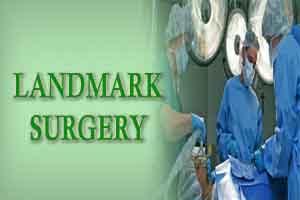- Home
- Editorial
- News
- Practice Guidelines
- Anesthesiology Guidelines
- Cancer Guidelines
- Cardiac Sciences Guidelines
- Critical Care Guidelines
- Dentistry Guidelines
- Dermatology Guidelines
- Diabetes and Endo Guidelines
- Diagnostics Guidelines
- ENT Guidelines
- Featured Practice Guidelines
- Gastroenterology Guidelines
- Geriatrics Guidelines
- Medicine Guidelines
- Nephrology Guidelines
- Neurosciences Guidelines
- Obs and Gynae Guidelines
- Ophthalmology Guidelines
- Orthopaedics Guidelines
- Paediatrics Guidelines
- Psychiatry Guidelines
- Pulmonology Guidelines
- Radiology Guidelines
- Surgery Guidelines
- Urology Guidelines
Landmark: Nose cells used to repair damaged knee joints.

In what may be termed as a landmark procedure, Swiss surgeons successfully used an experimental technique, which includes harvesting cells from the nasal septum, to repair damaged knee joints in patients.
Articular cartilage injuries have poor repair capacity, leading to progressive joint damage, and cannot be restored predictably by either conventional treatments or advanced therapies based on implantation of articular chondrocytes. Compared with articular chondrocytes, chondrocytes derived from the nasal septum have superior and more reproducible capacity to generate hyaline-like cartilage tissues, with the plasticity to adapt to a joint environment. Mumme et al aimed to assess whether engineered autologous nasal chondrocyte-based cartilage grafts allow safe and functional restoration of knee cartilage defects.
In a first-in-human trial, ten patients with symptomatic, post-traumatic, full-thickness cartilage lesions (2–6 cm2) on the femoral condyle or trochlea were treated at University Hospital Basel in Switzerland. Chondrocytes isolated from a 6 mm nasal septum biopsy specimen were expanded and cultured onto collagen membranes to engineer cartilage grafts (30 × 40 × 2 mm). The engineered tissues were implanted into the femoral defects via mini-arthrotomy and assessed up to 24 months after surgery. Primary outcomes were feasibility and safety of the procedure. Secondary outcomes included self-assessed clinical scores and MRI-based estimation of morphological and compositional quality of the repair tissue. The study is registered with ClinicalTrials.gov, number NCT01605201. The study is ongoing, with an approved extension to 25 patients.
The researches found that for every patient, it was feasible to manufacture cartilaginous grafts with nasal chondrocytes embedded in an extracellular matrix rich in glycosaminoglycan and type II collagen. Engineered tissues were stable through handling with forceps and could be secured in the injured joints. No adverse reactions were recorded and self-assessed clinical scores for pain, knee function, and quality of life were improved significantly from before surgery to 24 months after surgery. Radiological assessments indicated variable degrees of defect filling and development of repair tissue approaching the composition of native cartilage.
The researches concluded that the hyaline-like cartilage tissues, engineered from autologous nasal chondrocytes, can be used clinically for repair of articular cartilage defects in the knee. Future studies are warranted to assess efficacy in large controlled trials and to investigate an extension of indications to early degenerative states or to other joints.
The study has been published in the Lancet.

Disclaimer: This site is primarily intended for healthcare professionals. Any content/information on this website does not replace the advice of medical and/or health professionals and should not be construed as medical/diagnostic advice/endorsement or prescription. Use of this site is subject to our terms of use, privacy policy, advertisement policy. © 2020 Minerva Medical Treatment Pvt Ltd